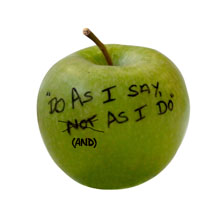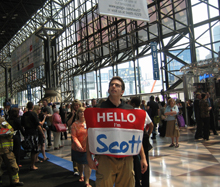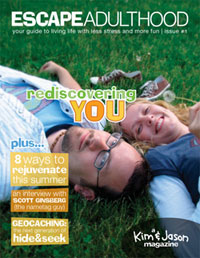 Where do you get your best ideas?
Where do you get your best ideas?
Late at night?
Early in the morning?
While sitting on a beach during sunset?
If you’re like me, you do your best thinking while exercising.
Running in the mountains. Swimming at the Y. Walking in the park.
Solvitas perambulatorum, as our Latin friends call it.
“Solving problems in the process of physical exercise.”
I first understood the power of this process during an 8 mile run on a 97-degree afternoon in the summer of 2005.
Maybe it was the heat.
Maybe it was the humidity.
Maybe it was the endorphins pumping through my veins as my ever-expanding mind drifted off to Creative La-La Land.
But by the time I finished my run, I had actually written an entire book!
I stumbled into my car. Grabbed my idea jotter. And as the sweat dripped off my chin and onto the paper, I frantically wrote down three words that would eventually change my business forever: BE THAT GUY.
One year later, the book How to be That Guy was released.
Wow, maybe I should go running more often! I thought.
LESSON LEARNED: working out works.
And here’s why:
According to The Artist’s Way, exercise clears your mind, stabilizes your emotions and levels your perspective.
It contributes to an increased production and release of endorphins. That results in a sense of euphoria that has been popularly labeled as the “runner’s high.”
“The rhythmic, repetitive action transfers the locus of the brain’s energies from the logic to the artist hemisphere. It is there inspiration bubbles up untrammeled by the constraints of logic,” Julia Cameron explains.
Furthermore, pumping rhythmically and repetitively also pumps the well of your creativity.
Working out works.
Even Thomas Jefferson was known for taking two-hour walks every day.
“The sovereign invigorator of the body is exercise,” he claimed, “and a strong body makes the mind strong.”
So, if you want to motivate your melon, consider the follow tips for practicing solvitas perambulatorum:
1. Do it daily. Even a fifteen-minute walk around the block counts. Remember, you’re working out your body AND your brain. There’s ALWAYS time. Get up earlier if you have to.
2. Do it rhythmically. Repetition allows you to get lost in the activity. That’s why running, walking and swimming are among the best choices. Repetition = Rhythm = Focus = Increased Creativity.
3. Do it intentionally. Right before you jump in the pool or hit the track, frame your mind. Start thinking about your present problem or new idea. Say to yourself, “OK brain, we’ve got a half hour to think about this. Let’s get crackin…”
4. Do it musically. Grab your iPod and start blasting some tunes. Consider creating your own playlist specifically for these creative situations. You’ll find that combining your senses expands your creative prowess. Plus, music is a great way to get lost in any activity. Plus, running to the Rocky IV soundtrack makes you feel really, really cool.
5. Do it and write it. If you’re walking, bring a notepad with you. If you’re running or swimming, have the notepad waiting when you’re done. There’s no doubt you’re going to get some great ideas, so you MUST write them down! Because if you don’t write it down, it never happened. And that which goes unrecorded goes unmemorable. REMEMBER: writing is the basis of all wealth.
6. Do it strategically. When should you exercise? When your mind draws a blank. When you’re stuck on a new idea. When you’ve been working on a new project for six straight hours. When you’ve got a long day of creative thinking ahead of you. All of these situations should set off the exercise alarm. (Plus, you can write off your new running shoes as a business expense!)
Ultimately, exercising the body relaxes the mind.
Sure, your muscles might be sore; but your brain will be chillin!
The goal is to make your brain feel like JELL-O. That way, your creative mind will mold into its most innovative, most amiable and most productive state.
Solvitas perambulatorum.
Because working out works.
Stretch your legs and you will stretch your mind.
LET ME ASK YA THIS…
Where do you get your best ideas?
LET ME SUGGEST THIS…
Share your best melon motivator here!
 * * * *
* * * *
Scott Ginsberg
That Guy with the Nametag
Download Scott’s new book!
Right here, right now, for FREE, no strings.

 It’s the most frequently asked question, like, ever.
It’s the most frequently asked question, like, ever. * * * *
* * * * * * * *
* * * * Next time someone says to you, “Do as I say, not as I do…”
Next time someone says to you, “Do as I say, not as I do…” * * * *
* * * * Everyone loves kids.
Everyone loves kids. * * * *
* * * * It’s not luck.
It’s not luck. * * * *
* * * * (To watch a video of The Giant Nametag, click
(To watch a video of The Giant Nametag, click  10. Dress it up. If you can find some sort of costume that’s consistent with your brand, do it. I wear a giant nametag to my conferences. Nobody misses me. Does your appearance stand out or blend in?
10. Dress it up. If you can find some sort of costume that’s consistent with your brand, do it. I wear a giant nametag to my conferences. Nobody misses me. Does your appearance stand out or blend in? * * * *
* * * * Shakespeare once said, “Action is eloquence.”
Shakespeare once said, “Action is eloquence.” * * * *
* * * * Growing up?
Growing up? * * * *
* * * * It’s rare to have an epiphany while standing in the middle of Hooters.
It’s rare to have an epiphany while standing in the middle of Hooters. * * * *
* * * *